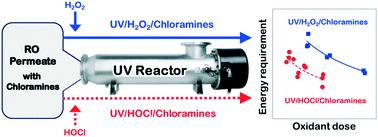当前位置:
X-MOL 学术
›
Environ. Sci.: Water Res. Technol.
›
论文详情
Our official English website, www.x-mol.net, welcomes your
feedback! (Note: you will need to create a separate account there.)
UV/chlorine vs. UV/H2O2 for water reuse at Orange County Water District, CA: a pilot study
Environmental Science: Water Research & Technology ( IF 3.5 ) Pub Date : 2020-07-17 , DOI: 10.1039/d0ew00316f Minhwan Kwon 1, 2, 3, 4, 5 , Alan Royce 1, 2, 3 , Ying Gong 1, 2, 3 , Kenneth P. Ishida 6, 7, 8, 9 , Mihaela I. Stefan 1, 2, 3
Environmental Science: Water Research & Technology ( IF 3.5 ) Pub Date : 2020-07-17 , DOI: 10.1039/d0ew00316f Minhwan Kwon 1, 2, 3, 4, 5 , Alan Royce 1, 2, 3 , Ying Gong 1, 2, 3 , Kenneth P. Ishida 6, 7, 8, 9 , Mihaela I. Stefan 1, 2, 3
Affiliation

|
On-site demonstration tests evaluated 1,4-dioxane removal in reverse osmosis permeate (RO permeate) at the Orange County Water District (OCWD) Advanced Water Purification Facility (AWPF). The study used a pilot-scale ultraviolet (UV) reactor to compare efficacy of UV/chloramine, UV/chloramine/H2O2 and UV/chloramine/HOCl advanced oxidation processes (AOPs). The UV/chloramine process did not achieve the targeted 0.5 log removal of 1,4-dioxane even at a high UV fluence of 4400 mJ cm−2 and the 1,4-dioxane decay did not follow pseudo-first order kinetics. Oxidant concentrations as low as 2.6 mg L−1 H2O2 or ∼1.0 mg L−1 free Cl2 (HOCl) in the RO permeate at ambient quality parameters, e.g. 2.2–2.4 mg L−1 monochloramine (as Cl2), 1.2–1.4 mg L−1 dichloramine (as Cl2), ≤0.08 mg L−1 NO2− (UV/H2O2 AOP), ∼97.0% T, resulted in 0.56 and ≥0.51 log reduction of 1,4-dioxane with the UV/chloramine/H2O2 and UV/chloramine/HOCl process, respectively, while simultaneously achieving ∼2.0 log reduction of NDMA. Overall, the UV/chloramine/HOCl process showed higher removal efficiency of 1,4-dioxane than UV/chloramine/H2O2 for the same mass-based oxidant concentrations and process conditions. Nitrite ions present in the RO permeate and/or generated from monochloramine photolysis during the UV/AOP impacted significantly the process performance. It was confirmed through these pilot-scale tests that the removal of 1,4-dioxane in the UV/chloramine/H2O2 and UV/chloramine/HOCl processes can be predicted accurately with a comprehensive mechanistic kinetic model that accounts for the molecular and radical reactions that occur in the RO permeate in the UV reactor.
中文翻译:

加利福尼亚橙县水区的紫外线/氯与紫外线/ H2O2的水回用:一项试点研究
现场演示测试评估了橙县水域(OCWD)高级净水设施(AWPF)中反渗透渗透液(RO渗透液)中1,4-二恶烷的去除率。该研究使用中试规模的紫外线(UV)反应器来比较UV /氯胺,UV /氯胺/ H 2 O 2和UV /氯胺/ HOCl高级氧化工艺(AOP)的功效。即使在4400 mJ cm -2的高紫外线通量下,UV /氯胺工艺也无法实现目标值的0.5 log对1,4-二恶烷的去除,并且1,4-二恶烷的衰变不遵循拟一级动力学。氧化剂浓度低至2.6 mg L -1 H 2 O 2或约1.0 mg L -1游离氯RO渗透物在环境质量参数下为2(HOCl),例如2.2–2.4 mg L -1一氯胺(作为Cl 2),1.2–1.4 mg L -1二氯胺(作为Cl 2),≤0.08mg L -1 NO 2 −(UV / H 2 O 2 AOP),〜97.0% T,通过UV /氯胺/ H 2 O 2和UV /氯胺/ HOCl工艺分别导致1,4-二恶烷的对数减少0.56和≥0.51log,同时使NDMA减少约2.0对数。总体而言,UV /氯胺/ HOCl工艺显示1,4-二恶烷的去除效率高于UV /氯胺/ H 2。O 2对于相同的基于质量的氧化剂浓度和工艺条件。在RO /渗透液中存在和/或在UV / AOP过程中由一氯胺光解产生的亚硝酸根离子显着影响了工艺性能。通过这些中试规模的测试证实,可以使用解释分子的综合力学动力学模型来准确预测UV /氯胺/ H 2 O 2和UV /氯胺/ HOCl工艺中1,4-二恶烷的去除。RO中发生的自由基反应会渗透到UV反应器中。
更新日期:2020-08-27
中文翻译:

加利福尼亚橙县水区的紫外线/氯与紫外线/ H2O2的水回用:一项试点研究
现场演示测试评估了橙县水域(OCWD)高级净水设施(AWPF)中反渗透渗透液(RO渗透液)中1,4-二恶烷的去除率。该研究使用中试规模的紫外线(UV)反应器来比较UV /氯胺,UV /氯胺/ H 2 O 2和UV /氯胺/ HOCl高级氧化工艺(AOP)的功效。即使在4400 mJ cm -2的高紫外线通量下,UV /氯胺工艺也无法实现目标值的0.5 log对1,4-二恶烷的去除,并且1,4-二恶烷的衰变不遵循拟一级动力学。氧化剂浓度低至2.6 mg L -1 H 2 O 2或约1.0 mg L -1游离氯RO渗透物在环境质量参数下为2(HOCl),例如2.2–2.4 mg L -1一氯胺(作为Cl 2),1.2–1.4 mg L -1二氯胺(作为Cl 2),≤0.08mg L -1 NO 2 −(UV / H 2 O 2 AOP),〜97.0% T,通过UV /氯胺/ H 2 O 2和UV /氯胺/ HOCl工艺分别导致1,4-二恶烷的对数减少0.56和≥0.51log,同时使NDMA减少约2.0对数。总体而言,UV /氯胺/ HOCl工艺显示1,4-二恶烷的去除效率高于UV /氯胺/ H 2。O 2对于相同的基于质量的氧化剂浓度和工艺条件。在RO /渗透液中存在和/或在UV / AOP过程中由一氯胺光解产生的亚硝酸根离子显着影响了工艺性能。通过这些中试规模的测试证实,可以使用解释分子的综合力学动力学模型来准确预测UV /氯胺/ H 2 O 2和UV /氯胺/ HOCl工艺中1,4-二恶烷的去除。RO中发生的自由基反应会渗透到UV反应器中。











































 京公网安备 11010802027423号
京公网安备 11010802027423号